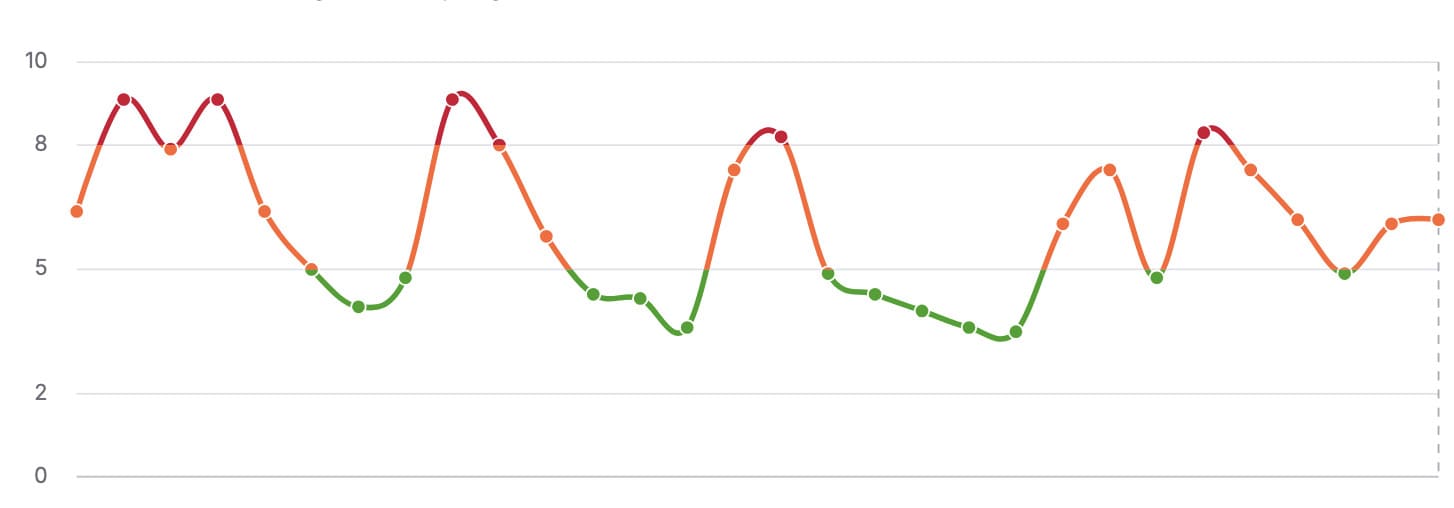Search rankings showed extreme movement throughout April 2025. Several confirmed spikes were recorded on April 2, April 4, April 9, April 16, April 22–23, and April 25, based on data from multiple SERP monitoring tools.
The volatility affected sites across multiple niches, with noticeable drops and recoveries happening in short windows. While Google has not officially confirmed a new update during April 2025.
Some were part of their Core Update system. Some looked like Spam Policy hits. And some may be small silent updates based on User Behavior Signals.
This Google search ranking volatility timeline report compiles ranking spikes, expert observations, and tool-based data to help site owners understand what happened — and when.
Google Ranking Volatility Timeline: April 1 to April 30, 2025
April 2025 was not calm for search rankings. It was full of fast ups and downs. We saw sudden spikes again and again across different days.
Multiple SEO tools like Semrush Sensor, MozCast, and Rank Ranger showed clear signs of search ranking volatility. Some sites dropped. Others jumped. And some kept going back and forth.
The movement hit many types of websites — news, reviews, e-commerce, and even small business blogs. Most spikes were linked to Spam System actions, user behavior shifts, or quiet changes in how Google reads search intent and content quality signals.
This timeline below shows all those spikes in one simple view — so you can track what happened, when it happened, and what might have caused it.
Here is the Google search ranking volatility score for spike dates in April 2025.
| Date | Volatility Score (avg) |
| April 2 | 9.1 |
| April 4 | 9.1 |
| April 9 | 9.1 |
| April 16 | 8.2 |
| April 22 | 8.1 |
| April 23 | 8.0 |
| April 25 | 8.3 |
Lost Rankings After the April Update?
We will audit your site find what hurt and help you get traffic back fast.
Every Major Google Ranking Spike in April 2025

April 2 – Volatility Score: 9.1
Search rankings jumped again just after the March Core Update finished. Tools like Semrush Sensor and MozCast showed clear movement. Some sites climbed fast. Others dropped out without warning. It was not a fresh update. It was the old one still settling.
Pages that lacked clear Search Intent or had poor Content Quality Signals got hit. The system still looked for meaning, not just keywords. Websites that covered their Entity Coverage well stayed stable.
Google search ranking volatility heats up April 2nd ish https://t.co/WZWkr8PgIJ pic.twitter.com/3ltM3ZayUz
— Barry Schwartz (@rustybrick) April 3, 2025
April 4 – Volatility Score: 9.1

This one hit review websites hard. Blogs with product comparisons, affiliate links, or “Top 10” lists saw massive drops.
The problem? Most of them had repeated blurbs or weak structure. The ones that ranked high shared real insights — not just specs.
Google stayed silent. But most signs pointed to a Review System refresh. Pages that lacked Entity Salience or failed to show Trust Signals lost rank fast.
April 9 – Volatility Score: 9.1

Biggest shake of the month. SEO forums buzzed. Tools spiked. Drops were sudden, especially on sites with thin content.
This looked like a Spam Policy action. Many sites that used clickbait, copied blocks, or doorway-style pages vanished from top spots.
Those that stayed? They had clear focus and no tricks. They followed Discourse Flow, answered real questions, and stayed on topic.
Google Search ranking volatility April 9th and 10th https://t.co/5ClgmSkcp8 pic.twitter.com/CCy8cYrMHb
— Barry Schwartz (@rustybrick) April 10, 2025
April 16 – Volatility Score: 8.2

Now the YMYL zones felt the heat. Finance blogs, health sites, even legal info hubs all saw ranking changes.
This movement was not random. It followed E-E-A-T signals closely. Sites that lacked author credibility or skipped source references were pulled down.
If you did not show Experience or Expertise, your ranking suffered. If you did? You were rewarded. Simple as that.
Google Search ranking volatility spikes around April 16th https://t.co/atGXPvdlBG
— SE Roundtable (@seroundtable) April 16, 2025
April 22 – Volatility Score: 8.1
This day felt like the start of another wave. Not one niche — many. Tools picked up broad changes. Webmasters called it “weird movement.”
It was possibly an unconfirmed adjustment. Sites with stale content, slow pages, or poor layout saw minor declines. Pages with Semantic Relevance and Topic Clarity performed better.
April 23 – Volatility Score: 8.0
Movements stayed steady. Sites that refreshed their pages recently stayed stable. The ones that stayed stale? They slid.
Many of them missed key User Behavior Signals — low time on page, high bounce rate, no scroll depth.
There was no clear word from Google. But the pattern felt familiar. It looked like tweaks to how Google tracks engagement. Maybe not a big update. But enough to shake up rankings.
April 25 – Volatility Score: 8.3

Final major spike. And it was a sharp one. Tools hit high again. Some brands saw major gains. Others were wiped out.
Common trend? Pages with poor mobile layout or over-optimized headers dropped. Pages that led with clear answers, fast load time, and Intent Matching rose fast.
This one ended the month with a message: clean structure, helpful tone, and Entity Linking matter more than ever.
Google search ranking volatility hits on Friday, April 25th https://t.co/PRh0FOwo0d
— SE Roundtable (@seroundtable) April 27, 2025
Patterns and Observations
April felt heavier than March. The Search Ranking Volatility was higher. Some days looked just like what we saw during the February Spam Systems rollout.
Pages with thin content, too many keywords, or no clear writer took a hit. Sites that had fake names or no author signals also lost ground. A lot of them had low Content Quality Signals — poor formatting, copied text, or weak user value.
But not everything dropped.
Websites that shared honest experience or had clear answers saw gains. Pages with helpful tone, strong Search Intent match, and verified brand trust got better spots.
This also showed signs of Core Update Recovery for some. Especially on pages that fixed old issues, improved structure, or added new expert content.
If your site stayed stable, chances are your content was focused, deep, and tied to real entities. If not, the gaps became visible.







